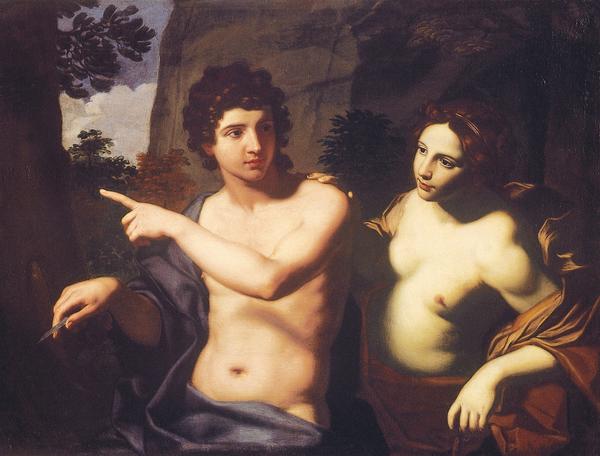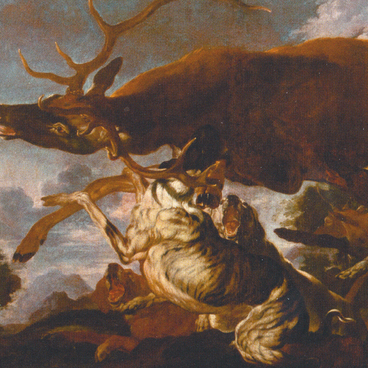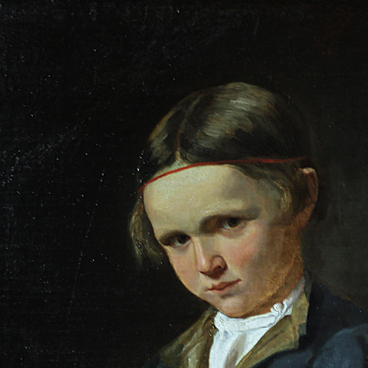For a long time, the picture was believed to be the work by German artist Angelika Kauffmann, while the happy couple pictured was considered to be Adam and Eve. The main argument for that was the inscription Anjelika pointed at by the character on the picture: the inscription was taken for the artist’s signature. Later, in the man’s other hand, a knife was discerned that had been used to carve the name: a detail contradicting to the version of the primal people.
In 1982, after several re-attributions, Victoria Markova, an employee of the A. S. Pushkin Museum of Fine Arts, attributed the painting to Michele Desubleo.
The Baroque artist Michele Desubleo, also called The Flemish, was born in Maubege, a French city then belonged to the Netherlands. Most likely, he learned painting in Flanders, in the studio of Abraham Janssens known for his religious and mythological paintings.
As from the first half of 1620s, Desubleo worked in Italian cities of Rome, Bologna, Venice and Parma. According to experts, the given picture dates to the Bolognian period. This is evidenced by distinguishing features of the local school: harmonious clarity of composition, sculptural finality of forms and generous, however artificial and coldish, gamut of colors.
A popular source of subjects for Bolognian School artists was the Italian poem Orlando Furioso by Ludovico Ariosto published in full in 1532. The author, inspired by exotic and picturesque tales of chivalry, developed adventures of dozens of characters in the space from China to Africa, including even a trip to the Moon. The subject shown in the picture resembles a significant episode of the poem.
One of the main stories of the poem is love of legendary knight Orlando to a light-minded Chinese girl Angelika, whose beauty caused a great war all over Christian and Moslem worlds. Orlando’s feelings remained unreciprocated: Angelika, having turned down many renowned heroes and monarchs, fell in love with rank-and-file Saracenic soldier Medor who was dying of wounds. She was fostering him a forest cabin, while recovering Medor decorated all the surroundings with inscriptions telling about his grateful love for Angelika. Then the happy lovers left for faraway lands. Roland, having come across their one-time shelter and having read Medor’s outpourings, learned everything and lost his mind, ‘went into the rampage that is never yet seen and will be even more terrifying if not seen’.
In 1982, after several re-attributions, Victoria Markova, an employee of the A. S. Pushkin Museum of Fine Arts, attributed the painting to Michele Desubleo.
The Baroque artist Michele Desubleo, also called The Flemish, was born in Maubege, a French city then belonged to the Netherlands. Most likely, he learned painting in Flanders, in the studio of Abraham Janssens known for his religious and mythological paintings.
As from the first half of 1620s, Desubleo worked in Italian cities of Rome, Bologna, Venice and Parma. According to experts, the given picture dates to the Bolognian period. This is evidenced by distinguishing features of the local school: harmonious clarity of composition, sculptural finality of forms and generous, however artificial and coldish, gamut of colors.
A popular source of subjects for Bolognian School artists was the Italian poem Orlando Furioso by Ludovico Ariosto published in full in 1532. The author, inspired by exotic and picturesque tales of chivalry, developed adventures of dozens of characters in the space from China to Africa, including even a trip to the Moon. The subject shown in the picture resembles a significant episode of the poem.
One of the main stories of the poem is love of legendary knight Orlando to a light-minded Chinese girl Angelika, whose beauty caused a great war all over Christian and Moslem worlds. Orlando’s feelings remained unreciprocated: Angelika, having turned down many renowned heroes and monarchs, fell in love with rank-and-file Saracenic soldier Medor who was dying of wounds. She was fostering him a forest cabin, while recovering Medor decorated all the surroundings with inscriptions telling about his grateful love for Angelika. Then the happy lovers left for faraway lands. Roland, having come across their one-time shelter and having read Medor’s outpourings, learned everything and lost his mind, ‘went into the rampage that is never yet seen and will be even more terrifying if not seen’.



